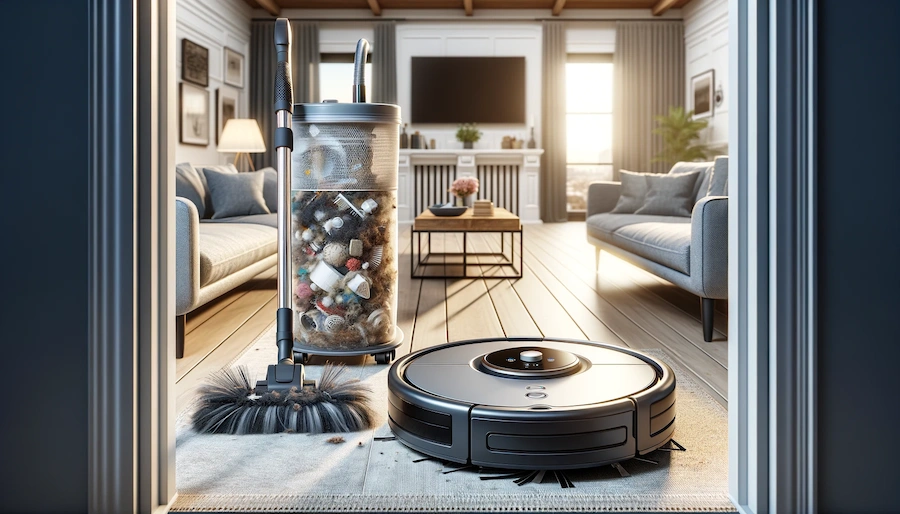Robot vs ‘Real’ Vacuums

So, there I was, staring at my cordless stick vacuum’s dustbin, and boy, it was a sight to behold. Just after my robotic buddy, the Q7, had done its rounds, I decided to give the old manual once-over. You wouldn’t believe the amount of gunk that thing left behind. We’re talking dust bunnies big enough to start their own ecosystem. It got me thinking—how effective are these robot vacuums, really? And how should we be using them to get our floors truly clean?
The Great Unveiling
Picture this: my trusty Q7 wraps up, feeling pretty pleased with itself. I come in with my upright vacuum, and voila, the dustbin’s brimming with all the stuff the Q7 missed. We’re not just talking a few stray crumbs; it’s like a treasure trove of dirt, dust, and hair. The kicker? The Q7’s bin wasn’t even full. So, what gives? Is it the suction power, or is there a secret to getting carpets really clean?
Rethinking Our Robotic Overlords
Here’s the deal: running a robot vac once a week or whenever we remember isn’t cutting it. I’ve seen the light (and the dirt), and the truth is, these gadgets thrive on routine. Daily runs, even double headers, could be the game changer, keeping the bulk of the debris at bay and making manual vacuuming a breeze.
The Bin’s the Thing
It’s tempting to think if we just empty the bin more often, our robot vacs would magically perform better. Sure, a full bin doesn’t help, but it’s not the whole story. Keeping filters clean and making sure not to overstuff the bin can improve performance, but it’s not a cure-all.
The Trusty Upright’s Role
Now, I’m not saying to ditch your robot vac. Far from it. But expecting it to replace the deep clean of a good old-fashioned vacuum might be a stretch, especially on carpets. The showdown with my upright vacuum was eye-opening, not because it showed the robot vac’s flaws, but because it highlighted each vacuum’s strengths.
What’s the Verdict?
After my little experiment, I’ve come to a couple of conclusions. First off, robot vacuums are not set-it-and-forget-it devices. They’re part of a broader cleaning strategy, best used daily to keep on top of the dirt and dust. And second, there’s still no beating the satisfaction (and necessity) of a deep clean with a traditional vacuum.
It’s all about balance. Let the robot handle the daily dust dance while you and your trusty upright come in for the deep clean disco. Together, you’ll keep your place looking and feeling fresh, no matter what life (or your floors) throw at you. So, go ahead, give your robot vac the daily runaround, and save yourself the surprise of a dustbin showdown. Your floors will thank you, and honestly, so will your sanity.
Robotic and Stick/Upright Vacuum FAQ
Q: Can robotic vacuums replace traditional vacuums completely?
A: Not quite. Robotic vacuums are fantastic for daily maintenance and keeping on top of dust and debris, but for a deep clean, especially in carpets, traditional vacuums are still necessary.
Q: How often should I run my robotic vacuum?
A: Daily runs are ideal. The more frequently you run your robotic vacuum, the better it can maintain cleanliness and reduce the workload of your traditional vacuum.
Q: Why did my robotic vacuum miss so much dirt?
A: It could be due to several factors, including the vacuum’s suction power, the type of floor, or simply the amount of dirt. Running it more frequently and ensuring its dustbin isn’t full can help improve its effectiveness.
Q: Is it necessary to clean the dustbin of my vacuum after every use?
A: Yes, regularly emptying the dustbin and maintaining the vacuum can significantly improve its performance and lifespan. For robotic vacuums, try not to let the bin exceed its maximum capacity.
Q: Can the brush type affect my vacuum’s cleaning efficiency?
A: Absolutely. Different brushes are designed for different types of surfaces. For example, a bristle brush might be more effective on carpets to lift hair and dirt. Check if your vacuum model allows for brush changes to optimize cleaning.
Q: How do I get rid of the smell from my vacuum’s dustbin?
A: Regularly washing and drying all components of the bin and cyclonic separators, if applicable, can help eliminate odors. For persistent smells, a non-chlorine bleach solution like hydrogen peroxide can be used to denature any remaining detritus.
Q: Can running a robotic vacuum too often damage my carpets or rugs?
A: It’s unlikely if you’re using the vacuum as intended. However, certain powerful vacuums might damage delicate rugs or carpets. It’s recommended to use a gentle setting or turn off the brush roll for these surfaces.
Q: Should I still manually clean my floors if I have a robotic vacuum?
A: Yes, while robotic vacuums are great for everyday maintenance, manual cleaning (whether vacuuming or mopping) is recommended for a thorough deep clean, at least once a month or as needed.